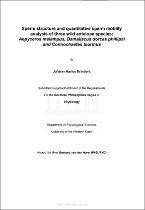| dc.description.abstract | The aim of this study was to compare sperm morphology, motility and the effects of cold treatment on Sperm of three wild antelope species', Aepyceros melampus (impala), Connochaetes taurinus (blue wildebeest) and Damaliscus Dorcas pnitipsi(blesbok). Animals were obtained from nearby hunting farms during the annual lrunting Season. For seasonal studies, special arrangements Were made with game farmers to also collect material during the non-hunting (summer) ,"r.6n. Samples were taken for the respective time-dependent experiments to assess morphology by means of (a) light microscopy, (b) scanning and transmission election microscopy, (c)iorputer aided sperm motion analysis' (d) sperm precooling to 4"C in Triladyl cryodiluent and (e) freezing of blue wildebeest sperm. For the sperm motility studies, cauda epididymal sperm from the three Species were incubated at various time intervals i.e. 15 minutes, 1, 3 and 6 hours.
The sperm head of impala, blesbok and blue wildebeest have a distinctive dorsoventrally flattened/spaiulate structure. Scanning electron microscopy (SEM) studies revealed possible species specific differences in head length:head width ratios; impala (0.63), blesbok (0.71), blue wildebeest (0.67). Various sperm abnormalities were identified with forms of the Dag defect being the most prominent.
The results showed very small changes in the percentage of viable sperm over a
period of six hours. Blue wildebeest had the highest percentage of live sperm at 1 hour, (81.o7%) followed by blesbok (76.5%) and then impala (74.13%)' The highest percentage of dead acrosome reacted Sperm was found at 6 hours in blesbok (19.67%)
Sperm motility studies indlcated species-specific differences. Sperm aspirated from the epididymis were incubated in Ham's F10 culture medium. Motility was assessed at l5minutes (blue wildebeest and impala), 1, 3 and 6 hours after incubation. The following sperm motility parameters were selected: curvilinear vetocity (VCL), Straightliie velocity (VSL), Linearity ILlry), Average Path velocity (VAp), Beat iross F-requency laif;, Dancemean (DNCmn), mean Amplitude of iateral head displacement (mnALH), maximum Amplitude of Lateral head
displacement (mxALH) and Mean Angular Deviation (MAD) At 15 minutes, staiistically significant ip<0.05) differences were found for VCL, VSL, VAP, mnALH, .*nLH, LlN, BCF and DNCmn, respectively among species.
At.1 hour, VCL, VSL, VAP, MAD, LlN, BCF and DNCmn were respectively statistically significantiy different for all three species. Mean amplitude of lateral head diiplacement differed statistically significantly (p<0 0001) when comparing Blue wildebeest to Blesbok. After 3 hours, vcl, vsl, vAP, mnALH, mxALH and MAD were the only parameters that were respectively statistically significantly different for the tnieb species. After 6 hours, VCL, VAP, mnALH, mxALH' LlN, BCF and DNCmn diffeied statistically significantly for all three species' Hyperactivation was not observed in-two of the three species, but indications were evident in Blesbok sperm. This was marked by increased VCL (p<0.0001)' DNCmn (p<0.0001), mnALH and mxALH (p<0.0001), decreased vsl (p<0.0001), VAP (p<0.0001) and LIN (p<0'0001)
Data collected for impala during the rainfall period and dry season showed that there was a seasonal effect on sperm motility parameters. The results were divided into winter period lgroupi) and rainy season (group2). Data compared for group 1 vs group 2 shoived differences ior VCL (253'25 t5'44 vs 251 '0 t7 '97 ' p ,-0.05;, VSLI1+O.gS t3.46 vs 62.44 t2.8, p<0.05), LIN (60.28 t0'95 vs 29'77 't1.54, p<O.OS), BCF (53.70 t1.38 vs 29.02 tl .54, p<0.05), vAP (170.91 t3.22 vs 116.39'+3.53, p<0.05) and mnALH (4.33 10.11 vs 6.51 t0.22, p<0.05)' From the
data obtained, it appears that season has an effect on sperm motility parameters,
except for VCL.
Precooling was performed on impala and blue wildebeest sperm' lmpala cauda epididymal sperm VCL after precooling showed-no statistically significant oirerehces fiom Z to 4 hours after rewarming. Precooled cauda epididymal rp"t, VSL, LlN, VAP, BCF and MAD showed a decline from 2 to 6 hours where DNCmn increased within the same time interval. Blue wildebeest precool data on the other hand showed an initial decrease from 1 lo 2 hours with an increase frOM 2 tO 3 hOUTS fOT VCL, VSL MNALH, MXALH, BCF, VAP DNCMN ANd MAD'
The difference between fresh and precooled sperm was determined for impala
and blue wildebeest.
Differences between treatments were dependent on time and the parameter measured. From the results obtained, it appears that both impala and blue wildebeest need only to be precooled for 2 hours' Blue wildebeest cauda epididymal sperm frozen at -196'C were analysed by means of transmission eiectron microscopy. Sperm for motion analysis were
recovered by means of a swim-up technique. Results showed that only 35% of
sperm recovered were tive. TEM studies showed damage to the sperm acrosome and plasma membrane. Live Sperm were detected by means of an acidophilic fluorescent dye (SYBR-14 Live/Dead kit) dual stained with Propidium lodide (Pl) staining the nuclei of dead sperm red. sperm motility analysis showed , of post thaw sperm motility similar to that found in fresh
ip"rr. Data of precooled sperm were in moit instances (VCL, VSL and BCF) the same as motifity immediately after thawing. This was probably due to the presence of glycerol in the medium. Post thaw sperm were washed in glycerolfree medium and allowed to swim-up. The swim-up technique is widely used to isolate motile, progressively swimming sperm from a freezelthaw or semen sample. For the rl*ir-up sample, in ilris study, only a few were progressively motile with individual sperm displaying high progressive motility'. | en_US |

